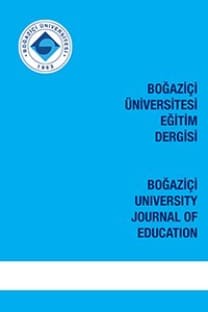El Sanatları ve Matematik: Cebir Dünyasına Bakış
El sanatları, fonksiyon, izometri, grup teorisi, matematik öğretimi
Handcrafts and Mathematics: A Look into the World of Algebra
___
- Akpınarlı, G., Büyükyazıcı, O. ve Kurt, E. (2010). Hemşin Çamlıhemşin el örgüsü çoraplar. Gazi Üniversitesi Bap Projeleri (1. baskı). Ankara.
- Baker, A. (2005). Groups and symmetry. Ders notu. University of Glasgow, UK.
- Bixler, H. N. (1980). A group-theoretical analysis of symmetry in two dimensional patterns from Islamc art (Yayınlanmamış doktora tezi). New York University.
- Feyzioğlu, A. (2016). Yayınlanmamış ders notları. Boğaziçi Üniversitesi: İstanbul.
- Hoggar, S. G. (2006). Mathematics of digital images: Creation, compression, restoration, recognition. UK: Cambridge University Press.
- Hollebrands, K. F. (2003). High school students’ understandings of geometric transformations in the context of a technological environment. The Journal of Mathematical Behavior, 22, 55-72.
- Kutlu, S. B. ve Kutlu, B. (1990). Modern temel matematik: Soyut matematiğe giriş. İstanbul: Fil Yayınevi
- Portnoy, N., Grundmeier, T. A. ve Graham, K. J. (2006). Students’ understanding of mathematical objects in the context of transformational geometry: Implications for constructing and understanding proofs. The Journal of Mathematical Behavior, 25, 196-207.
- Sarıkaya Hünerel, Z. ve Er, B. (2012). Halk kültürünün tanıtılmasında el sanatlarının yeri ve önemi. Journal of Life Sciences, 1(1), 179-190.
- Steketee, S. ve Scher, D. (2006). Connecting functions in geometry and algebra. Mathematics Teacher, 109(6), 448-455.
- Sünker, S. ve Zembat, I.O. (2012). Teaching of translations through use of Vectors in Wingeom-tr environment. Elementary Education Online, 11(1), 173-194.
- Yanık, H. B. (2014). Middle-school students’ concept images of geometric translations. The Journal of Mathematical Behavior, 36, 33-50.
- Yanık, H. B. (2011). Prospective middle school mathematics teachers’ preconceptions of geometric translations. Educational Studies in Mathematics, 78, 231-260.
- Yanık, H. B. ve Flores, A. (2009). Understanding rigid geometric transformations: Jeff’s learnig path for translation. The Journal of Mathematical Behavior, 28, 41-57.
- Zembat, I. O. (2013a). Geometrik dönüşümlerden öteleme ve farklı anlamları. I. O. Zembat, M. F. Özmantar, E. Bingölbali, H. Şandır ve A. Delice (Haz.), Tanımları ve tarihsel gelişimleriyle matematiksel kavramlar (s. 629-644). Pegem Akademi: Ankara.
- Zembat, I.O. (2013b). Geometrik dönüşümlerden dönme ve özellikleri. I. O. Zembat, M. F. Özmantar, E. Bingölbali, H. Şandır ve A. Delice (Haz.), Tanımları ve tarihsel gelişimleriyle matematiksel kavramlar (s. 645-658). Pegem Akademi: Ankara
- ISSN: 1300-9567
- Yayın Aralığı: 3
- Başlangıç: 1976
- Yayıncı: Boğaziçi Üniversitesi
Ebeveynlerin Çocuklarıyla Cinsellik Hakkında Konuşma Stratejileri ve Öz-Yeterlikleri
Seda DONAT BACIOĞLU, Dilber TEZEL
El Sanatları ve Matematik: Cebir Dünyasına Bakış
Zekeriya KARADAĞ, Gülseren KARAGÖZ AKAR
Elifcan ÖZTEKİN, Ferah ÖZER, Mervenur BELİN, Arif BÖYÜKSOLAK, Güneş ERTAŞ, Gizem MUTLU GÜLBAK, Melek PESEN, Vuslat ŞEKER, Canan TÜRKMEN
Teknoloji Destekli Öğrenme Ortamlarında Parabol Kavramının Soyutlanması Sürecinin İncelenmesi
